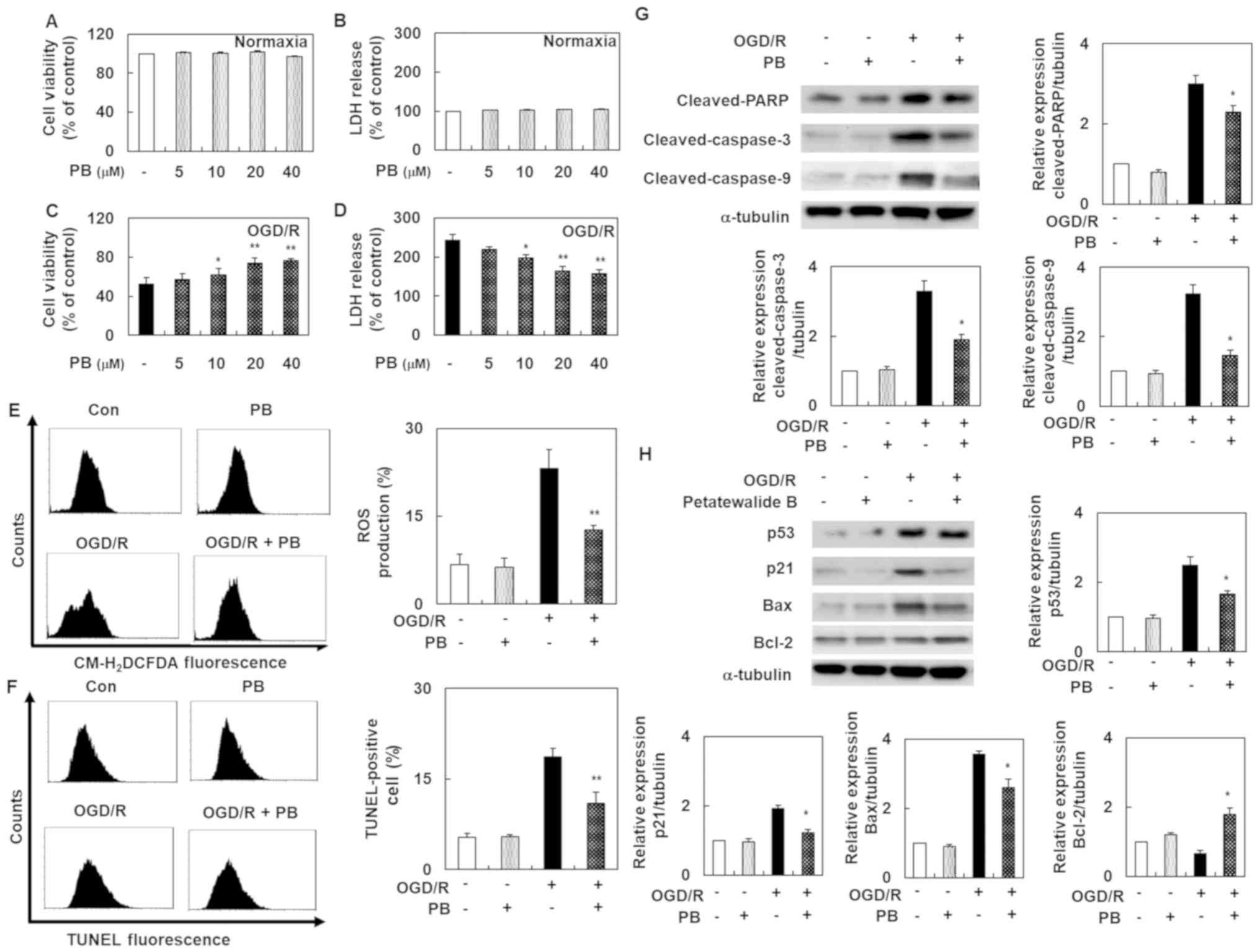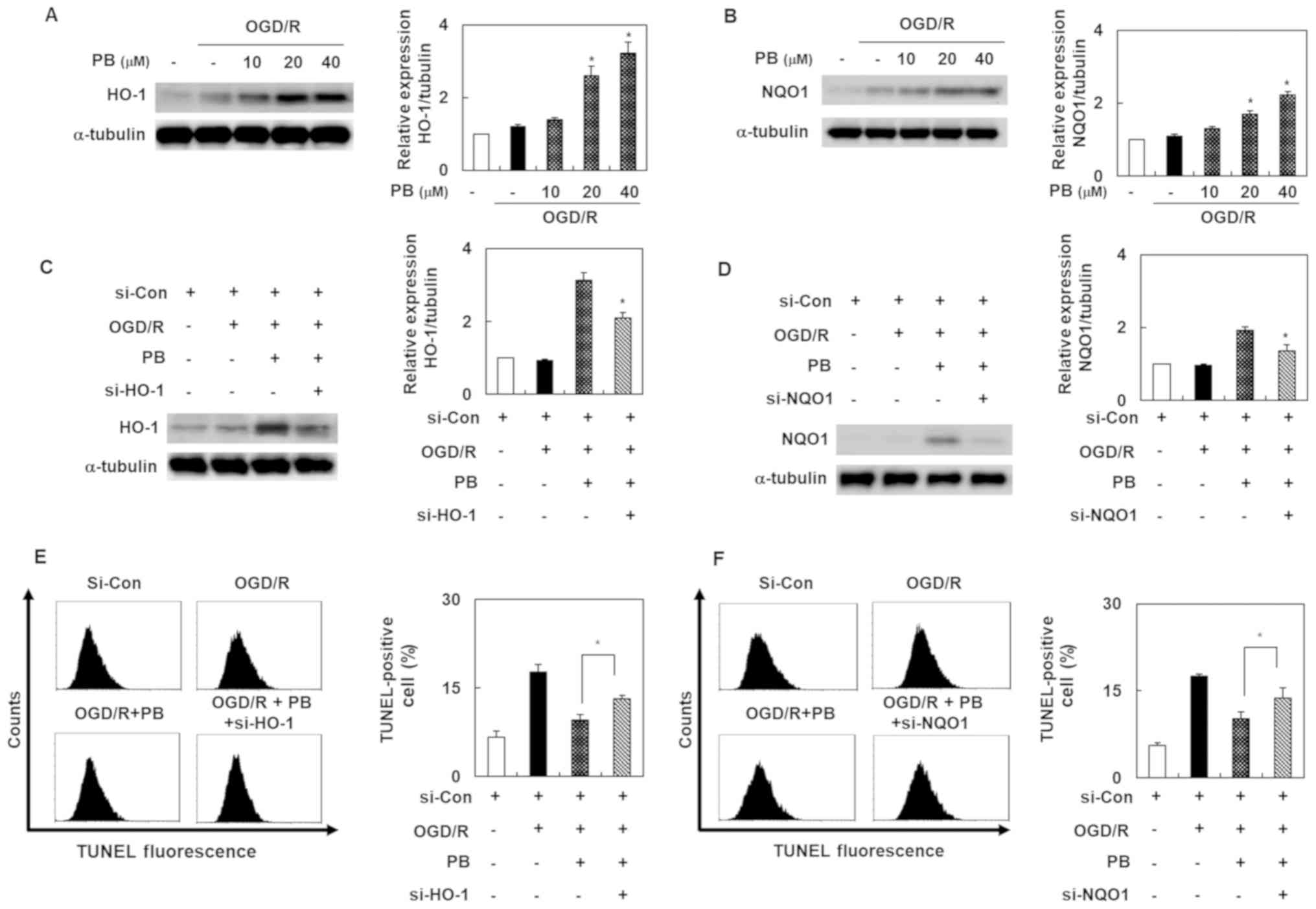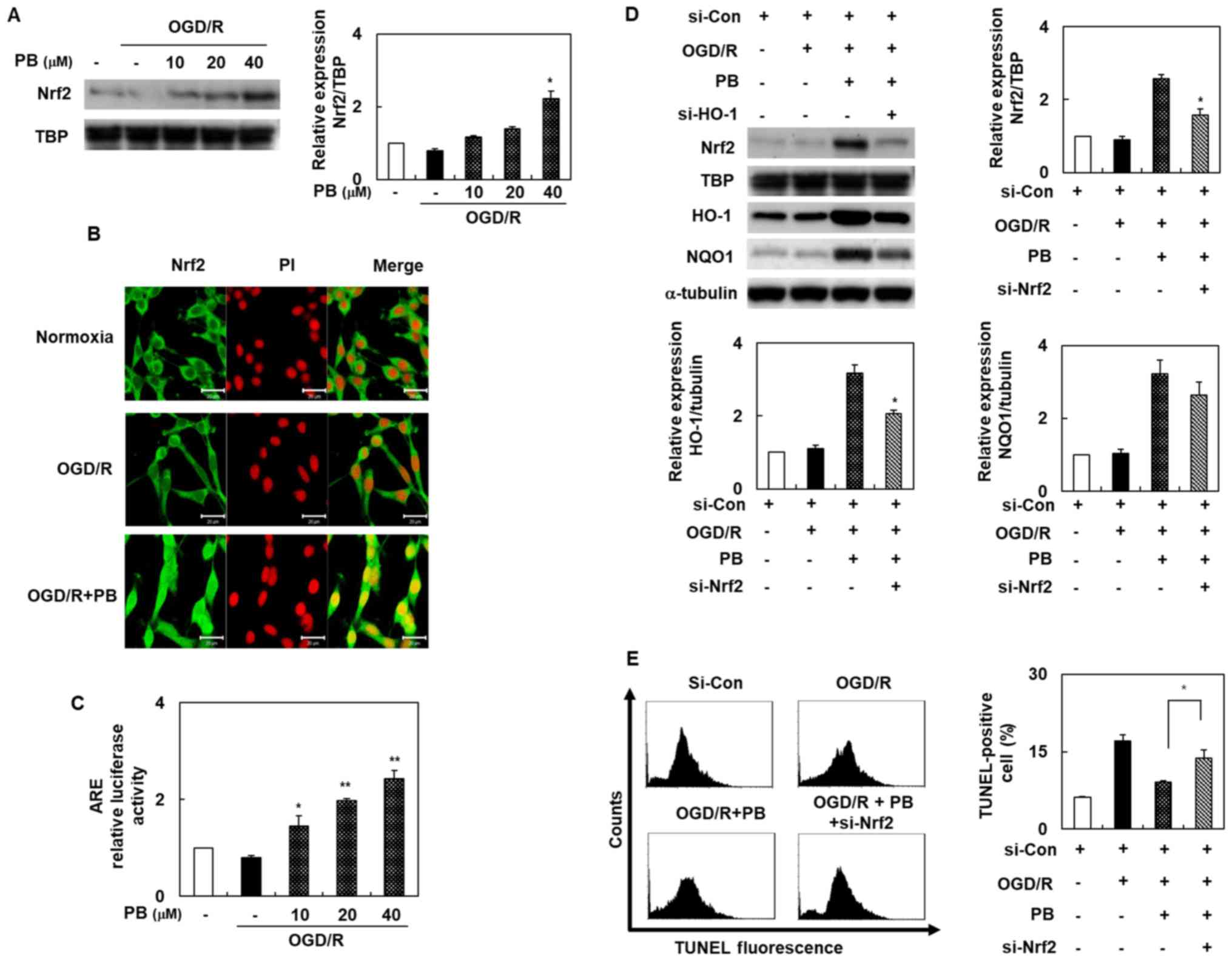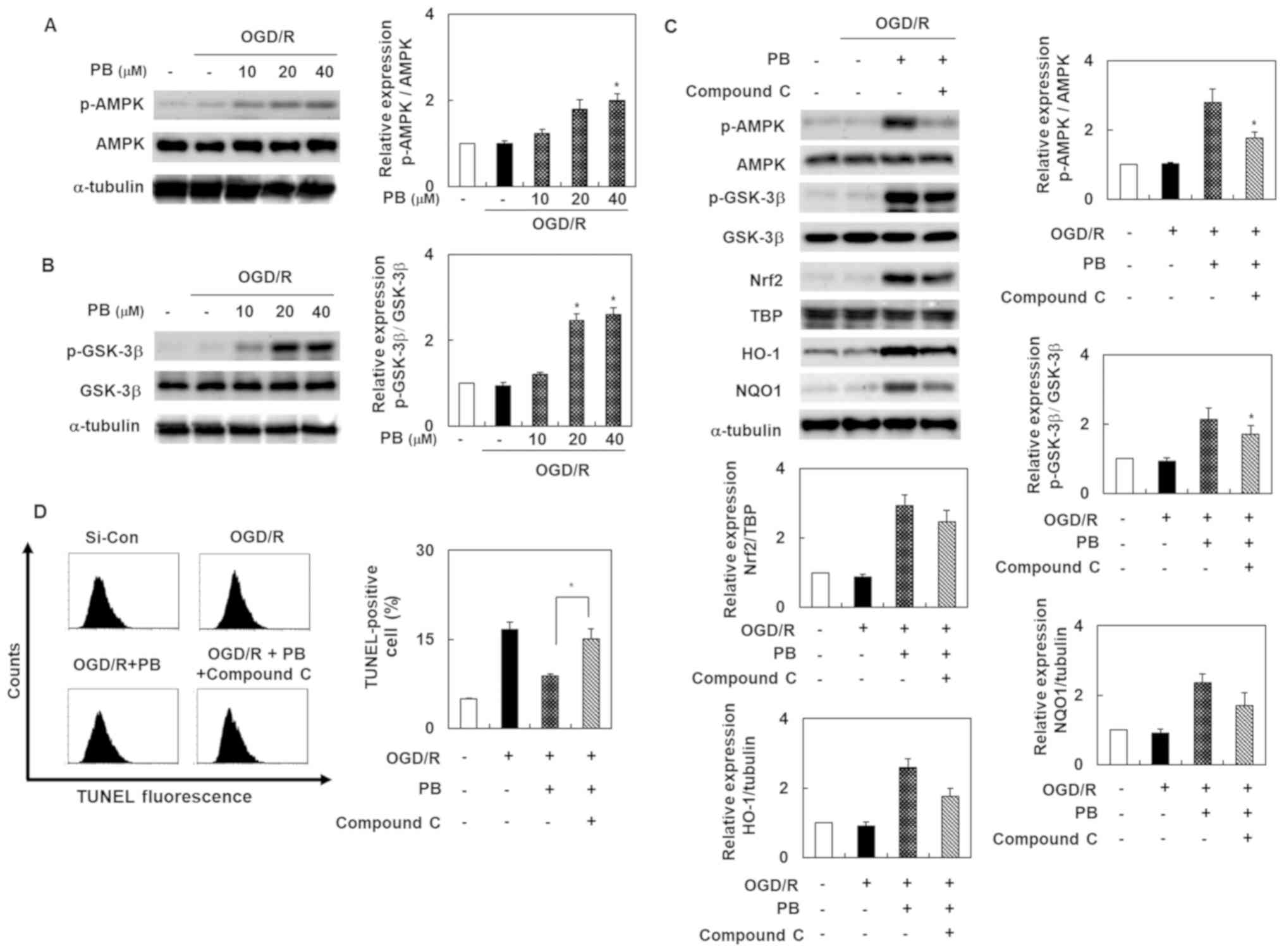|
1
|
Wang J, Wang A, He H, She X, He Y, Li S,
Liu L, Luo T, Huang N, Luo H, et al: Trametenolic acid B protects
against cerebral ischemia and reperfusion injury through modulation
of microRNA-10a and PI3K/Akt/mTOR signaling pathways. Biomed
Pharmacother. 112:1086922019. View Article : Google Scholar : PubMed/NCBI
|
|
2
|
Dong RF, Tai LW, Zhang B, Shi FK, Liu HM,
Duan PC and Cheng Y: Neuroprotective effect of FMS-like tyrosine
kinase-3 silence on cerebral ischemia/reperfusion injury in a
SH-SY5Y cell line. Gene. 697:152–158. 2019. View Article : Google Scholar : PubMed/NCBI
|
|
3
|
Hu S, Wu Y, Zhao B, Hu H, Zhu B, Sun Z, Li
P and Du S: Panax notoginseng saponins protect cerebral
microvascular endothelial cells against oxygen-glucose
deprivation/reperfusion-induced barrier dysfunction via activation
of PI3K/akt/Nrf2 antioxidant signaling pathway. Molecules.
23:E27812018. View Article : Google Scholar : PubMed/NCBI
|
|
4
|
Feng L, Gao J, Liu Y, Shi J and Gong Q:
Icariside II alleviates oxygen-glucose deprivation and
reoxygenation-induced PC12 cell oxidative injury by activating
Nrf2/SIRT3 signaling pathway. Biomed Pharmacother. 103:9–17. 2018.
View Article : Google Scholar : PubMed/NCBI
|
|
5
|
Sun X, Li X, Ma S, Guo Y and Li Y:
MicroRNA-98-5p ameliorates oxygen-glucose deprivation/reoxygenation
(OGD/R)-induced neuronal injury by inhibiting Bach1 and promoting
Nrf2/ARE signaling. Biochem Biophys Res Commun. 507:114–121. 2018.
View Article : Google Scholar : PubMed/NCBI
|
|
6
|
Li F, Liang J and Tang D: Brahma-related
gene 1 ameliorates the neuronal apoptosis and oxidative stress
induced by oxygen-glucose deprivation/reoxygenation through
activation of Nrf2/HO-1 signaling. Biomed Pharmacother.
108:1216–1224. 2018. View Article : Google Scholar : PubMed/NCBI
|
|
7
|
Yin WL, Yin WG, Huang BS and Wu LX: LncRNA
SNHG12 inhibits miR-199a to upregulate SIRT1 to attenuate cerebral
ischemia/reperfusion injury through activating AMPK signaling
pathway. Neurosci Lett. 690:188–195. 2019. View Article : Google Scholar : PubMed/NCBI
|
|
8
|
Ting-Ting L, Yuan G, Jun L, Dan X and
Hong-Bo T: GSK621 attenuates oxygen glucose
deprivation/re-oxygenation-induced myocardial cell injury via
AMPK-dependent signaling. Biochem Biophys Res Commun. 514:826–834.
2019. View Article : Google Scholar : PubMed/NCBI
|
|
9
|
Duan Q, Sun W, Yuan H and Mu X:
MicroRNA-135b-5p prevents oxygen-glucose deprivation and
reoxygenation-induced neuronal injury through regulation of the
GSK-3β/Nrf2/ARE signaling pathway. Arch Med Sci. 14:735–744. 2018.
View Article : Google Scholar : PubMed/NCBI
|
|
10
|
Duan J, Cui J, Yang Z, Guo C, Cao J, Xi M,
Weng Y, Yin Y, Wang Y, Wei G, et al: Neuroprotective effect of
apelin 13 on ischemic stroke by activating AMPK/GSK-3beta/Nrf2
signaling. J Neuroinflammation. 16:242019. View Article : Google Scholar : PubMed/NCBI
|
|
11
|
Zhou F, Wang M, Ju J, Wang Y, Liu Z, Zhao
X, Yan Y, Yan S, Luo X and Fang Y: Schizandrin A protects against
cerebral ischemia-reperfusion injury by suppressing inflammation
and oxidative stress and regulating the AMPK/Nrf2 pathway
regulation. Am J Transl Res. 11:199–209. 2019.PubMed/NCBI
|
|
12
|
Adachi Y, Kanbayashi Y, Harata I, Ubagai
R, Takimoto T, Suzuki K, Miwa T and Noguchi Y: Petasin activates
AMP-activated protein kinase and modulates glucose metabolism. J
Nat Prod. 77:1262–1269. 2014. View Article : Google Scholar : PubMed/NCBI
|
|
13
|
Choi YW, Lee KP, Kim JM, Kang S, Park SJ,
Lee JM, Moon HR, Jung JH, Lee YG and Im DS: Petatewalide B, a novel
compound from Petasites japonicus with anti-allergic
activity. J Ethnopharmacol. 178:17–24. 2016. View Article : Google Scholar : PubMed/NCBI
|
|
14
|
Kitajima M, Okabe K, Yoshida M,
Nakabayashi R, Saito K, Kogure N and Takayama H: New otonecine-type
pyrrolizidine alkaloid from Petasites japonicus. J Nat Med.
73:602–607. 2019. View Article : Google Scholar : PubMed/NCBI
|
|
15
|
Park SY, Choi MH, Li M, Li K, Park G and
Choi YW: AMPK/Nrf2 signaling is involved in the
anti-neuroinflammatory action of Petatewalide B from Petasites
japonicus against lipopolysaccharides in microglia.
Immunopharmacol Immunotoxicol. 40:232–241. 2018. View Article : Google Scholar : PubMed/NCBI
|
|
16
|
Wang S, Jin DQ, Xie C, Wang H, Wang M, Xu
J and Guo Y: Isolation, characterization, and neuroprotective
activities of sesquiterpenes from Petasites japonicus. Food
Chem. 141:2075–2082. 2013. View Article : Google Scholar : PubMed/NCBI
|
|
17
|
Yao X, Yao R, Yi J and Huang F:
Upregulation of miR-496 decreases cerebral ischemia/reperfusion
injury by negatively regulating BCL2L14. Neurosci Lett.
696:197–205. 2019. View Article : Google Scholar : PubMed/NCBI
|
|
18
|
Zeng Z, Zhang Y, Liang X, Wang F, Zhao J,
Xu Z and Liu X and Liu X: Qingnao dripping pills mediate
immune-inflammatory response and MAPK signaling pathway after acute
ischemic stroke in rats. J Pharmacol Sci. 139:143–150. 2019.
View Article : Google Scholar : PubMed/NCBI
|
|
19
|
Sun B, Ou H, Ren F, Huan Y, Zhong T, Gao M
and Cai H: Propofol inhibited autophagy through
Ca2+/CaMKKβ/AMPK/mTOR pathway in OGD/R-induced neuron
injury. Mol Med. 24:582018. View Article : Google Scholar : PubMed/NCBI
|
|
20
|
Young Park S, Jin Kim Y, Park G and Kim
HH: Neuroprotective effect of Dictyopteris divaricata
extract-capped gold nanoparticles against oxygen and glucose
deprivation/reoxygenation. Colloids Surf B Biointerfaces.
179:421–428. 2019. View Article : Google Scholar : PubMed/NCBI
|


















